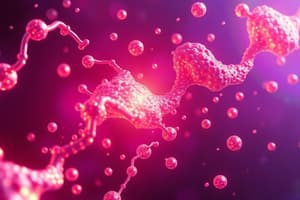Podcast
Questions and Answers
Inorganic salt, an organic solvent (e.g., alcohol or chloroform), or ______.* without alteration of the molecule's primary structure, i.e., without cleavage of any of the primary chemical bonds that link one amino acid to another.
Inorganic salt, an organic solvent (e.g., alcohol or chloroform), or ______.* without alteration of the molecule's primary structure, i.e., without cleavage of any of the primary chemical bonds that link one amino acid to another.
heat
Method: 1- Take 1 ml of protein Albumin. 2- Place it in a boiling water bath for 5-10 minutes. 3-Remove aside to cool to room temperature. 4-Note the ______.
Method: 1- Take 1 ml of protein Albumin. 2- Place it in a boiling water bath for 5-10 minutes. 3-Remove aside to cool to room temperature. 4-Note the ______.
change
Do you think free amino acids will give a positive result with biuret test? ______?
Do you think free amino acids will give a positive result with biuret test? ______?
why
What is the least number of amino acids bonded together by peptide bonds that will respond positively to biuret test?
What is the least number of amino acids bonded together by peptide bonds that will respond positively to biuret test?
After heating albumin at high temperature, does it still biologically active? ______?
After heating albumin at high temperature, does it still biologically active? ______?
Can we use salting out method in fractionating mixture of proteins? ______ your result with example.
Can we use salting out method in fractionating mixture of proteins? ______ your result with example.
Is it necessary to alter the molecule's primary structure to get a positive result in the biuret test? ______?
Is it necessary to alter the molecule's primary structure to get a positive result in the biuret test? ______?
What are some examples of organic solvents that can be used in protein analysis? ______ or chloroform
What are some examples of organic solvents that can be used in protein analysis? ______ or chloroform
Is cleavage of primary chemical bonds necessary for the biuret test? ______
Is cleavage of primary chemical bonds necessary for the biuret test? ______
What should be the final step after noting the change in the protein during the experiment? ______ to room temperature
What should be the final step after noting the change in the protein during the experiment? ______ to room temperature
Flashcards are hidden until you start studying
Study Notes
Qualitative Tests of Protein
- Functional groups in proteins react to form characteristically colored products, with color intensity linked to the number of reactive groups and their accessibility.
- Biuret Test: Specific for peptide bonds, detecting the presence of peptides/proteins.
- Requires at least two peptide linkages for a positive result.
- Involves treating proteins with an alkaline CuSO₄ solution, resulting in a violet color indicating presence. Color density correlates with protein amount.
- Biuret reagent is alkaline copper sulfate solution.
Protein Precipitation
- Used in downstream processing to concentrate and purify proteins from contaminants.
- Protein solubility affected by pH, temperature, salts, and heavy metal salts.
Effect of Salt Concentration on Protein Solubility
- Low salt concentrations enhance solubility (salting in) by attracting salt ions to protein functional groups.
- High salt concentrations lead to precipitation (salting out) as ions compete with protein for water, causing dehydration.
- Each protein has a specific salt concentration for precipitation.
- High molecular weight (Mw) proteins require low salt concentrations; low Mw proteins need high concentrations.
- Example: Egg proteins separated by centrifugation, where albumin (low Mw) remains in supernatant and globulin (high Mw) precipitates.
Precipitation by Acids
- Investigates effect of strong acids on protein solubility, where high acidity increases positive charge and leads to precipitation.
- In experiments, concentrated nitric acid and Trichloroacetic acid (TCA) are used to observe precipitation of albumin.
Precipitation by Heavy Metal Salts
- Heavy metal salts (Hg²⁺, Pb²⁺, Ag⁺, etc.) disrupt salt bridges in proteins, leading to insoluble metal-protein salts.
- Objective is to assess the impact of heavy metal salts on protein solubility through neutralization of the protein's negative charge.
Protein Denaturation
- Investigates the impact of high temperatures on protein structures.
- Non-covalent bonds are broken by heat, resulting in denaturation and precipitation of proteins.
- Denaturation involves loss of quaternary, tertiary, and secondary structures due to external factors like heat, strong acids, or bases.
Studying That Suits You
Use AI to generate personalized quizzes and flashcards to suit your learning preferences.




